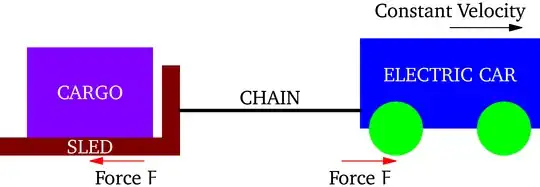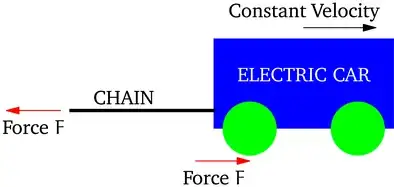Is work still equal to force times distance if there is no acceleration?
Consider an electric car pulling a sled at a constant velocity as shown. The static friction force $F$ at the wheels is equal to the sliding friction force on the sled. Since the forces are balanced, there is no acceleration.
Assume a distance $D$ is traveled at this constant velocity. The work done by the car is force times distance, or $W=FD$.
In this scenario, the tension in the chain will also be equal to the force $F$ as shown below.
I believe the diagram below is enough to determine the work done by the car. The details of the sled are not important. The work done by the car is $W=FD$ regardless if there is a sled at the end of the chain, a trailer with its brakes applied, or a person pulling on the chain. The force in the chain is sufficient to calculate the work done by the car.
Now suppose that the force in the chain increases to $2F$ while the car increases its power output to maintain the constant velocity. I contend that the work done by the car doubles for the same distance traveled, $W=2FD$.
Am I correct so far?
Compare this scenario of a car with a similar question regarding work done by a dog on a leash. Is it more work to put more (apparent) effort to get the same outcome? In this question, the car is replaced by a dog and the sled is replaced by a walking person.
I contend that, for a given walking distance, the dog will do more physics work when the leash force is greater. I understand that the dog will also do extra work because - unlike the car - it is not 100% efficient. For example, the dog will be jumping around and wasting some energy.
There are many reasons people in the other question give for why the dog's physics work is NOT increased when the leash force is higher, including...
- The person is not moving faster when the dog pulls harder.
- The person is walking. If the person was sliding then the work would be higher.
- "Force is mass times acceleration. If you are pulling harder but not actually speeding up, then it isn't force."
None of these reasons seem correct to me, but they seem to be the majority opinions in the question about dogs. Can someone clear up my (or their) misunderstanding?

